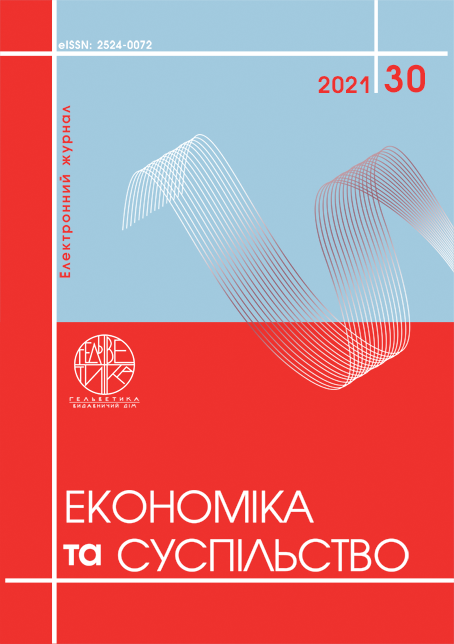STATE REGULATION OF MIGRATION PROCESSES IN UKRAINE: CONCEPTUAL AND APPLIED CHARACTERISTICS
Abstract
The article is devoted to the aspects of formation and implementation of the state policy of regulation of migration processes in Ukraine. The relevance of state policy in this area is highlighted. It is shown that high and growing volumes of migration processes in Ukraine threaten the sustainable development of the national economy. They lead to the leaching of intellectual and human resources for the functioning of the economy and regions of Ukraine. A comprehensive analysis of migration processes in Ukraine was conducted, in particular, the volumes and structural characteristics of migration processes in Ukraine against the background of the Carpathian region were assessed. The labour market as a factor of the conditions of flows’ migration is studied. A system of factors that stimulate or restrain migration processes in the country is formulated. The analysis found that factors such as the unemployment rate, the level of employment in the informal sector of the economy, the rate of employment, the average monthly wage and the rate of forced underemployment have the greatest impact on general migration trends. The influence of labour market parameters on the migration activity of the population of Ukraine based on multifactor regression is modelled. The regional migration policy is characterized. The level of migration activity of the population from Ukraine toward Poland, as well as the social and economic consequences of increasing labour migration are predicted. The main provisions of the concept of the regional program of regulation of migration processes are offered. Effective measures for employment sphere are identified such as a key factor in stabilizing migration processes. It is substantiated that in Ukraine there should be significant changes in the system of state regional management of migration processes, which directly consider the peculiarities of migration sentiments. The importance of introduction in Lviv region of the system of programming, monitoring, control of migration tendencies, to improve institutional and organizational relations between subjects of migration regulation, to intensify activity on preparation and realization of joint interstate educational, research and business projects, to improve stimulation of economic youth activities and appropriate institutional infrastructure. The implementation of these tools will increase the effectiveness of regional human resources conservation policy, especially in rural areas of the Carpathian region of Ukraine.
References
Anyanwu J., Erhijakpor E. Do remittances affect poverty in Africa? African Development Review, 2010, 22(1), 51–91.
Durand J., Massey S., Zenteno R. Mexican Immigration in the United States. Latin American Research Review, 2001, 36(1), 107–127.
Mulska O., Baranyak I. Formation of the forecasting model for Ukrainian-German migration system. Economy and forecasting. 2019. Vol. 2, pp. 119–136.
Махонюк О.В., Мульска О.П. Аналіз діяльності суб’єктів ринку міграційних послуг в Україні. Соціально-економічні проблеми сучасного періоду України. Збірник наукових праць. Вип. №5 (133). 2018. С. 128–133.
Геєць В.М. Економіка України: ключові проблеми і перспективи. Економіка і прогнозування. 2016. № 1. С. 7–22.
Libanova E. Labour migration from Ukraine: key features, drivers and impact. Economics and Sociology, 2019, 12(1), pp. 313–328. DOI: https://doi.org/10.14254/2071-789X.2019/12-1/19/
Васильців Т.Г., Іляш О.І., Лупак Р.Л. Проблеми та засоби конвергенції соціальної безпеки в Україні та ЄС. Бізнес Інформ. 2018. №12 (491). URL: https://cyberleninka.ru/article/n/problemi-ta-zasobikonvergentsiyi-sotsialnoyi-bezpeki-v-ukrayini-ta-es.
Omata N. The Complexity of Refugees’ Return Decision-Making in a Protracted Exile: Beyond the Home-Coming Model and Durable Solutions. Journal of Ethnic and Migration Studies, 2013, 39 (8), 1281–1297.
Anyanwu, J. & Erhijakpor, E. (2010) Do remittances affect poverty in Africa? African Development Review, 22 (1), 51–91. DOI: https://doi.org/10.1111/j.1467-8268.2009.00228.x
Durand, J., Massey, S. & Zenteno, R. (2001) Mexican Immigration in the United States. Latin American Research Review, 36 (1), 107–127. Retrieved from: https://www.russellsage.org/sites/all/files/durand_massey_chapter1_pdf_0.pdf
Mulska, O. & Baranyak, I. (2019) Formation of the forecasting model for Ukrainian-German migration system. Economy and forecasting, 2, 119–136. Retrieved from: https://ideas.repec.org/a/eip/journl/y2019i2p119-136.html
Makhonyuk, O.V. & Mulska, O.P. (2018) Analiz diyalʹnosti sub'yektiv rynku mihratsiynikh posluh v Ukrayini [Analysis of the activity of the subjects of the migration services market in Ukraine]. Socio-economic problems of the modern period of Ukraine. Collection of scientific works, 5 (133), 128–133. Retrieved from: http://nbuv.gov.ua/UJRN/sepspu_2018_5_22 (in Ukrainian)
Heyets, V.M. (2016) Ekonomika Ukrayiny: klyuchovi problemy i perspektyvy [Economy of Ukraine: key problems and prospects]. Economy and Forecasting, 1, 7–22. Retrieved from: http://nbuv.gov.ua/UJRN/econprog_2016_1_3 (in Ukrainian)
Libanova, E. (2019) Labour migration from Ukraine: key features, drivers and impact. Economics and Sociology, 12(1), pp. 313–328. DOI: https://doi.org/10.14254/2071-789X.2019/12-1/19
Vasyltsiv, T., Ilyash, O. & Lupak, R. (2018) Problemy ta zasoby konverhentsiyi sotsialʹnoyi bezpeky v Ukrayini ta ES [Problems and means of social security convergence in Ukraine and the EU]. Business Inform. Retrieved from: https://cyberleninka.ru/article/n/problemi-ta-zasobi-konvergentsiyi-sotsialnoyi-bezpeki-v-ukrayini-ta-es. (in Ukrainian)
Omata N. (2013) The Complexity of Refugees’ Return Decision-Making in a Protracted Exile: Beyond the Home-Coming Model and Durable Solutions. Journal of Ethnic and Migration Studies, 39 (8), 1281–1297. DOI: https://doi.org/10.1080/1369183X.2013.778149


